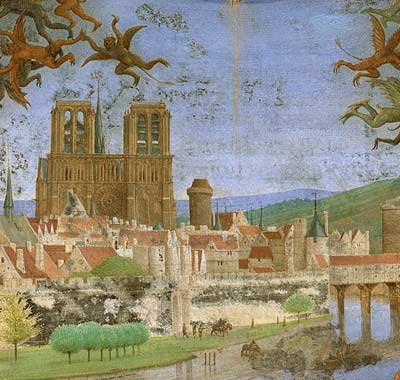Léonin and Pérotin (late 12th and early 13th centuries)

A view of medieval Paris showing the cathedral of Notre-Dame, where Léonin and Pérotin worked, from the 15th-century Book of Hours by Etienne Chevalier.
Léonin and Pérotin – sometimes referred to as Master Leoninus and Master Perotinus – were the best-known of a group of composers who worked in medieval Paris in the late 12th and early 13th centuries. This was the age of King Philippe-Auguste (Philippe II), during whose reign, from 1180 to 1223, the medieval kingdom of France was consolidated. Little is known of the lives of Léonin and Pérotin, but both are associated with the cathedral of Notre-Dame de Paris, whose foundations were laid in the mid 1160s, and its high altar consecrated in 1182.
Léonin
The major work attributed to Léonin was the Magnus liber ("great book") designed for use by the choir of the new cathedral. He is mentioned by an anonymous 13th-century theorist as "the best composer of organum for the amplification of divine service", suggesting that he wrote polyphonic settings for two independent voices of parts of the liturgy intended for performance on the main feast-days of the church's year. Léonin may also have been among the first to indiate rhythm as well as pitch in his musical notation. His vocal writing was imaginative, free-flowing, and improvisatory in style.
Pérotin
Some time after Léonin's death, Pérotin, who may have been his pupil, seems to have revised and shortened the Magnus liber. Pérotin remains a shadowy figure. He may have been born around 1160, and died some time between 1205 and 1225. Some scholars have suggested that he may have worked at the royal parish church of St Germain-l'Auxerrois, near the Tuileries Palace, since there is no direct evidence that he worked at Notre-Dame.
Pérotin was active in the creation of the four-voice motet, an ecclesiastical musical form which survives to the present day. His contribution towards the development of three- and four-voice polyphony was one of the most important steps forward in musical history. Of his works, two graduals in four voices for the Christmas season survive, as do about a dozen liturgical works in three voices, and about 160 clausulae – polyphonic passages written for insertion into liturgical plainsong to vary the texture.


